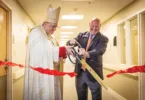
by Marc and Julie Anderson
mjanderson@theleaven.org
It’s been a problem since the 1980s.
Called “ag stress,” it refers to pressures felt by farmers or those within the agricultural industry. It can lead to depression, despair and even suicide.
According to the Centers for Disease Control and Prevention, the suicide rate among farmers is 1.5 times the national rate.
In fact, numerous reports from state and national government entities over the past several years indicate farmers have the highest suicide rates among any profession. Experts say the rate could increase dramatically if steps aren’t taken to address ag stress.
“The problem is real. We cannot ignore that fact,” said Father Arul Carasala, pastor of Sts. Peter and Paul Parish in Seneca.
Father Carasala should know.
Since 2004, he has served as a priest in rural communities like Fidelity, Wetmore, Kelly and Blaine. Most towns in which he’s served have a population of 300 or fewer.
Throughout his ministry, he’s gotten to know hundreds of families, many of whom own small family farms.
Likewise, Brad Dirks, a physician’s assistant in psychiatry since 1981 and the Kansas State University Research and Extension behavioral health specialist, has treated hundreds of patients — the vast majority of whom have been members of rural farm communities. He said the COVID-19 pandemic is creating additional stress.
Still, if there’s one message he’d like to offer everyone, it’s hope.
“I think we’re really at the beginning of a serious mental health problem that’s going to escalate, but I don’t want to make it sound hopeless because the good news is that I’ve never seen so many resources being brought into play, and everyone is recognizing it now.”
At 28, Ben Hasenkamp, a member of St. Patrick Parish in Corning (pop. 163), has farmed for 10 years. In fact, he’s one of the many fourth-generation farmers found in Nemaha County. He’s always trying to learn, so he researches as much as he can about the agricultural industry. Growing up, he heard stories from other local farmers, including those shared by family members.
In the 1970s, Hasenkamp said, expansion was key.
“At that time, everybody raised hogs,” he noted. “Everybody milked cows. Bankers were pushing farmers to build bigger milk barns, bigger hog facilities and produce more row crop.”
Then, the bottom fell out, especially here in the Midwest.
According to farmprogress.com, the recession caused the price of farmland to drop by 60% in some parts of the Midwest between 1981 and 1985.
Coupled with policies enacted by the Federal Reserve — policies aimed at bringing down high interest rates that had reached upwards of 20% — and record production, the prices that farmers could get for their crops dropped dramatically.
By 1984, farm debt had hit $215 billion, double what it had been in 1978.
Unlike the 1980s, today’s interest rates are low, but that may not help farmers’ debt loads.
For example, Hasenkamp has heard stories of land selling for as low as $500 to $800 per acre in the 1980s. Nowadays, an acre costs around $3,000. So, despite low interest rates, farmers often have trouble making loan payments.
“Land prices are jacked up so high, and if your money is tied up in the land and you lose your crop, you’re not able to make your payment. So, you have the risk of losing the farm,” Father Carasala said.
Ben Hasenkamp’s older brother Nick, a member of St. Michael the Archangel Parish in Leawood, was born in 1986 during the farm crisis. In addition to land being expensive, he said other costs make farming costly.
“Land is not cheap. And not only is it not cheap, many times it’s not available,” he said. “When it is available, you pay a premium. Then, of course, you need the equipment to produce the crops.”
Equipment doesn’t come cheap either.
According to agservicefinder.com, as of March of this year, a new combine costs between $330,000 and $500,000 on average. That’s one piece of equipment.
With 400 acres invested in corn and soybeans, Ben tries to buy used equipment. Sometimes though, farmers are forced to purchase new equipment in order to ensure time isn’t lost on repairs during planting season or harvest.
In farming, timing is everything.
“Farming is almost like gambling,” Father Carasala said.
“They put the crop in, trusting in God there will be perfect weather until the harvest,” he continued. “Sometimes, it depends on the prices. One week, they could be pretty high, and you are gambling to wait and see if the prices will go up a little bit.”
Prices can drop dramatically, sometimes overnight.
“That’s why I use the word gambling. If you’re lucky, you might be able to sell at the right time and at the right price,” Father Carasala said.
Then, there’s the time involved.
Sometimes, Father Carasala said, in order to keep up with the harvest, farmers run machines all night long. Not seeing their families can create a sense of guilt. That’s why he always schedules major parish activities during the slower times of the farming cycle.
Even so, he’s been grateful through the years to see that farmers always find time for Mass.
Growing up, Nick Hasenkamp witnessed the immense faith of the farmers in his family.
“Farmers have more faith than anybody else on the face of this earth,” he said. “What other job requires you to only work the ground and plant the seed, and then you have nothing left to do until it comes time to harvest?”
Yet the weather in between planting and harvest can wreak havoc.
“It’s too wet; it’s too dry,” Dirks said. “There can be serious flooding. If you live in a place where you do a lot of irrigation and you’re told you can’t because the aquifer is low, then all of a sudden that creates significant stressors.”
Add in the volatility of the markets, impacted by governmental policies. Recently, the pandemic has added uncertainty which, according to Dirks, is going to cause a ripple effect in the next year or so as farmers confront the economic fallout.
Ben Hasenkamp has witnessed the pandemic’s effects firsthand.
Every weekday, he drives four hours — one way — to a beef processing plant in Nebraska. As of mid-May, that plant’s daily production had been cut in half — from 1,800 head to roughly 800 or 900 due to staffing shortages and shifting markets demands.
That means cattle farmers are spending more money on feed to keep cows alive until they can sell them — or worse, euthanizing animals.
“I’ve heard from farmers saying they’ve had to dump a whole tank of milk. There’s no place they can take it to. They’ve had to put down their pigs and cattle,” said Father Carasala.
Meanwhile, the prices farmers receive for cattle are plummeting.
According to modernfarmer.com, as of this past April, prices were down 16%.
“The cost of goods, the cost of resources, the cost of fuel, everything continues to increase on a yearly basis,” Nick Hasenkamp said, “yet you continue to see a decline in the return.
“So, expenses catch up, and you risk losing the family farm, which has been in the family for generations. That’s a heavy cross to carry.”
And what happens if a farmer has major medical issues?
Oftentimes, Dirks said, even if the debt doesn’t wipe out the farm, it can add another level of stress.
For the Hasenkamps, declining health played a large role in their father’s mental state near the end. Tragically, Bob Hasenkamp took his own life in late 2010.
It’s only been in the past five years or so that Nick said he’s gained a deeper appreciation of the mental anguish his father must have felt.
“You have a small farm. You have seven kids, and you’re in a remote, rural community,” he said. “His health was declining, which means the medical bills were increasing. You’ve got kids that were growing, and grocery bills that were increasing, and they were pouring their hearts into giving us all that we needed.”
“He was put on this earth to farm,” Nick continued, “but he was losing the ability to do the work himself, and relying on others to do the work.
“That’s a really hard thing to do.”
Dirks agreed. He’s seen cases where farmers suffered horrible injuries, but kept right on working.
“They say, ‘Well, no one else can do that. I’m the only one here,’” said Dirks.
“So, if they’re sick, if they’re sad or if they’re stressed, they just put their head down and go,” he added. “That’s just part of the culture. You wouldn’t be a farmer if you weren’t a self-starter, self-motivating, if you just couldn’t get in there and do it.
“Whether your farm makes or breaks it, it’s up to you. There’s no one else.”
Asking for help, Ben said, is tough for farmers, mostly because they are intensely independent and proud.
“Farmers . . . we’re just a different breed,” he said. “You don’t really talk about problems with others. We pretty much see each other at the bar or the local co-op, but you don’t really talk much.
“You talk about the weather, but you don’t talk about anything important. So, everything’s just buried.”
Calling pressures faced by farmers today “unprecedented,” Dirks said many will not seek help.
“We have a lot of pressures we’ve never had before, and it’s impacting people to the point where they know they’re not making it economically and they have no options,” he said. “And so, they turn that in on themselves.”
Additionally, he said that isolation is often associated with depression, and farmers are certainly isolated. They can spend hours by themselves.
Ben spends around 12 hours driving every weekday, rarely making it home before 7 p.m. Then, it’s time for farm chores. Most nights, he eats supper around 9 or 10, leaving him little time to spend with his wife Jordan.
Families, Dirks said, are critical in relieving mental stress.
“When you’re stressed, you don’t do well at relationships,” he said, “and then the relationship which should have been a supportive thing is not one of support now because you tend to be angry and irritable and push people further [away], and further socially isolate.
“It leads to a snowball effect. We further socially isolate and [don’t] spend time with family and then a lot of us are too proud to say, ‘Hey, I’m struggling here.’ We have a lot of pride, so it’s really hard to go in.”
Farmers, Father Carasala said, even struggle to talk to priests.
When a farmer seeks his help, he listens awhile, trying to assess their needs. If he refers someone to a counselor, he follows up later from time to time.
“We struggled back in the ’80s with having resources for people,” said Dirks. “But I have never seen so many resources [as are available today]. So many organizations understand the need and are doing something about it. . . . It’s amazing.”
“There are resources available,” Dirks added. “The trick is how do we get individuals who need that help to be willing to ask for it?”







This is a well researched, carefully written article that should get widespread distribution. I wish every parishioner across America could read it! Bravo!